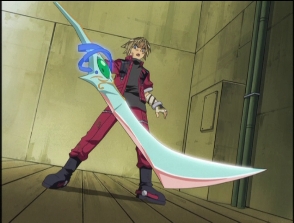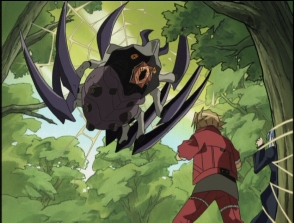|
The
line between animé and video games seems to be growing
ever thinner these days. It's a fact that, at least in Japan,
the two entertainment mediums are closely related, especially
when it comes to role-playing games; animators like Dragon
Ball's Akira Toriyama have designed video game worlds
and characters, and there's a lot of overlap between many
animé series and traditional turn-based Japanese
RPGs. While its references are not as overt as the previously-reviwed
OVA Gestalt, new
release Elemental Gelade clearly shows its connections
to the gaming world: its plot and characters could've been
lifted straight from any recent Japanese RPG. And indeed,
upon reading the plot synopsis provided to me by the distributor,
it seemed that this was, quite explicitly, the case.
Elemental
Gelade's main character is Cou, a sky pirate by profession.
He's a member of a larger group of pirates that sail the
skies robbing wealthy travelers and generally behaving as
most pirates do. One day, the pirates steal a strange casket;
Cou's curiosity gets the better of him, and he opens it
to discover a young girl inside. Pursued by forces that
seek to use the girl's mysterious powers for their own nefarious
ends, Cou must protect her from harm.
Sounding
familiar already? While the plot point of a pirate discovering
a girl in a locked box is lifted straight from Outlaw
Star, the "sky pirate" theme (and the oft-used plotline
of the protagonist having to protect the girl) is reminiscent
of the Sega Dreamcast's Skies of Arcadia, a video
game RPG that features a sky pirate who must protect a strange
girl with mysterious powers. I was braced for what appeared
to be a direct homage in theme and characterisation – thankfully,
this isn't the case at all.

Going
back to the plot: it's revealed that the girl, whose name
is Ren, is an Edel Raid – an ancient race who can bond with
humans and, in a process called "reacting", grant them special
powers to aid them in battle. Cou and Ren and joined by
three "protectors", who are intent on delivering Ren to
their Edel Raid sanctuary, but beyond that their intentions
are unknown. The protector group is led by Cisqua, a forceful
young girl adept in martial arts and gunplay. Backing her
up is the scholarly Rowan, and his partner Kuea – another
Edel Raid. The series focuses on the relationships between
humans and Edel Raids; in particular, it looks at how Edel
Raids are treated as slaves or tools by much of the population.
The sky pirate angle is all but forgotten by the end of
the second episode, leaving a straightforward "traveller's
journey" animé whereby the five friends must get
to either Cou's destination, the mystical city of Edel Garden,
or Cisqua's choice, her group's home base.
There
are five episodes (of twenty-six) here to kick off the series
in Volume 1, subtitled "React":
1:
"The Songs of the Sky and Wind"
Cou discovers Ren on a routine pirate raid. Cisqua's
group take an interest in her safety – but so do some marauding
ninjas.
2:
"A Fateful React"
With the pirate ship lost, and Cisqua's group stranded,
Cou and Ren decide to let Cisqua and the others follow them
to Edel Garden. Stopping over at a kindly villager's house,
Ren is kidnapped by the evil Beazon.
3:
"Betrayl & Confusion"
Cou, Cisqua, Rowan and Kuea storm Beazon's castle in order
to find and rescue Ren.
4:
"Elemental Gelade of Light and Darkness"
Cou and Ren join together to beat Beazon and escape his
castle.
5:
"The Teardrop From That Day"
While Cisqua mulls over dreams about her past, Cou meets
an old friend and decides to train himself in martial arts
so that he can protect Ren without reacting with her.

Elemental
Gelade uses humour as well as drama to drive the story
forward. Much of it is delivered deadpan-style as humourous
quips and in-jokes between the characters, though there's
the usual reactionary physical style of animé humour
where the characters' proportions distort to show emotional
reactions – it fits well with the artistic style of the
series. There is some use of slapstick humour, but nothing
on the level of Twin
Signal's blatant overuse of the style. One particular
bit of humour that had me in stitches was, ironically, a
traditional slapstick moment – Cou fights through a montage
of traps inside Beazon's castle, including flying blades
and pits full of spikes, and just as he thinks he's safe...
he's hit in the face by a custard pie, seemingly from out
of nowhere. Action scenes are fluid, using mostly sword
and gun techniques interspersed with more complex "magic"
usage and fantasy weaponry.
Gelade's
general art style reminds me of the Yu-Gi-Oh series
– basic and clean, without making any unique moves of its
own. For the most part, it's unassisted by CGI. The setting
of Gelade's world is curious – on the surface, it's
medieval, but with modern influences such as guns, grenades
and combustion engines. This is often reflected in character's
costumes – for example, Cisqua typically wears basic medieval-style
travelling robes, but throws them off in combat to reveal
denim shorts and a cut-off t-shirt. Character design is
good all round, putting some original spins on the design
of pirates and ninjas.
In
terms of music, it's once again back to Europe. Very decentralised,
though – one minute we're given Latin chanting for battle
themes, the next it's upbeat Celtic violin tunes. The English
voice acting is pretty good despite several unnatural pauses,
with voices well-suited to each character and voice actors
who sound like they're enjoying themselves.
In
conclusion, Elemental Gelade is a very enjoyable
animé series that, despite its various connections
and plot points from other sources, doesn't disappoint.
Fans of Japanese RPGs will immediately be drawn into the
familiar environments and characters. I came out of watching
this first volume wanting more, and with Volume 2 due for
release in mid-July, it looks like I won't have long to
wait.
The
4:3 picture appears to be an NTSC to PAL conversion but
it's a good one, with detail, contrast and colour all of
a pleasing standard. As with most such conversions, there
is some minor blurring on rapid motion, but otherwise there
are no significant issues here.
Both
the original Japanese and the expected English dub are available
in Dolby 2.0 stereo only. Both are clear, well mixed and
have a good dynamic range.
Just
the basics: textless opening and ending
and trailers for Gun Sword and Saiyuki
Reload.
|